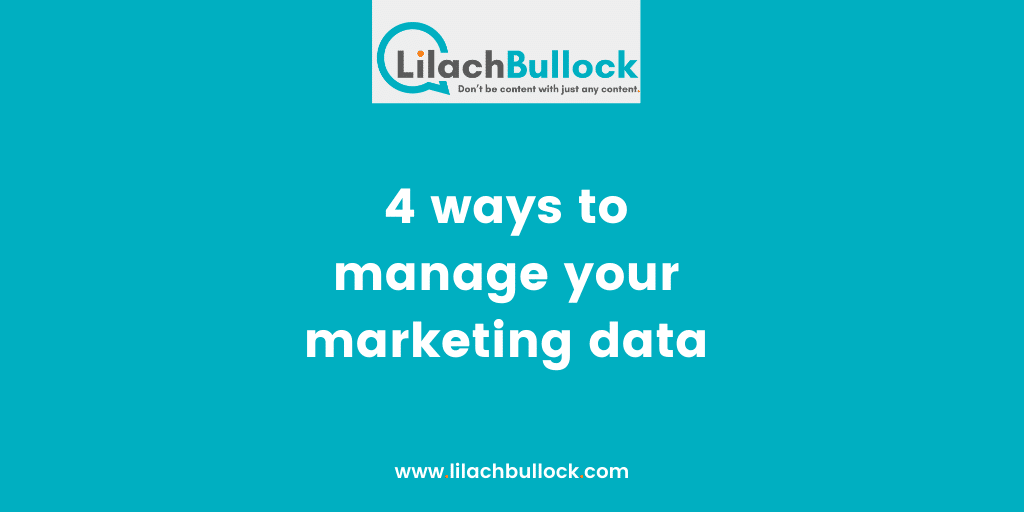Follow Lilach

4 ways to manage your marketing data
As a data-driven industry, marketing is heavily dependent upon accurate, complete and valid data to guide decisions and resources. With today’s consumers interacting with brands through many different touch points, the variety of data being received is constantly changing. This is why it is more important than ever for marketers to manage their customer data and maintain its integrity. In this article, we discuss four strategies on how to successfully manage your marketing data so you can make accurate and informed decisions for your business.
4 ways to manage your marketing data:
Decide on your critical data
The marketing world is awash with customer data, but is it actually relevant to what the marketers want to achieve? Marketers love to collect customer data, but it’s important to be mindful as to whether or not you’re actually going to use that information. If you don’t need it to define customer segments then forget about it. Instead, only focus on collecting the information that is important.
Also keep in mind where the customer is in the user journey before deciding what data you harvest. Let’s say your first point of contact is a form on your website, do you need the customer’s name, email, phone, country, annual turnover and product they’re interested in? Or will their name and email do for now and you can progressively collect the rest at a later date? If it isn’t critical at the first stage, remove it as a requirement. Doing so can also increase the number of form completions. A study by Blivakker in Norway found that removing unnecessary fields in a form increases the number of registrations so remove these where you can.
Avoid silos
With such a wide variety of systems connecting consumers to brands, its more important than ever for these touch points to form a cohesive and consistent brand experience. Having siloed data is the antithesis of this.
Data may be stored in different departments, or different systems may handle different sets of data, such as billing, shipping and customer service records. Separating data into silos like this removes the ability for brands to make informed decisions about their customers. A seamless customer journey is impossible when data isn’t shared between internal departments.
This isn’t limited to the online data either. The more traditional PR departments and customer-facing roles, like the call centre staff, have access to an enormous amount of data based on actual conversations with customers. This information can lead to much richer insights compared to the one-way feedback you get from online surveys.
The entire marketing team, both online and offline, need to pool their insight in order for company decision makers to make the best choices about what their customers are really looking for.
Implement ongoing data management
Now that you’ve identified your critical data and have removed the silos between departments and data, it’s time for a data management process.
With so many sources of data coming in from so many different departments, it’s easy for gaps, errors and inconsistencies to appear. If left unchecked, this can lead to customers receiving marketing materials that are duplicated, inaccurate or irrelevant. This is a sure fire way to turn customers off your brand.
Having a data management process is a vital part of ensuring you get the most accurate results from your customer data. Indeed, Bill Tennant, VP of Sales at ZAP describes data management as:
…the fundamental bedrock that sits alongside, and ensures you get the most efficient and accurate analysis
Manually performing this process can be incredibly time-consuming and a significant drain on resource. The most effective way to ensure your data remains clean, consistent and complete is to use a data management tool.
Data Management tool are incredibly powerful and can end up saving you hundreds of hours in unnecessary labour time. An effective data management tool will be able to carry out a range of tasks automatically, including the following:
Data collection and unification
Different departments may use different systems for collecting and storing data. Sales may use a CRM system, HR may use a Saas HRM tool whereas finance use Excel spreadsheets. A data management tool will be able to pull all of this information into one complete data source, ready for preparation.
Data preparation
Once your data has been unified, it will need to be cleansed and standardised to ensure consistency and avoid duplication. For example, a data management tool should be able to identify if the record for Jon Smith at 11 Chancey Lane, Warwickshire is the same or different to Jon Smith, 11 Chancy Ln, Warwickshire or Jonathan Smith, 11 Chancey Lane, Warks. Identifying and consolidating this information would remove that risk that Mr Smith receives three identical marketing materials.
Having a piece of data management software collect, unify and cleanse your data will then allow you to analyse a comprehensive data set with your chosen BI tool, whether that be Power BI, Qlik, Tableau or another Self-service BI tool. This will give you a much greater level of insight into customer behaviour than if you had been using many inconsistent data sources. It will also help you to achieve the holy grail of customer data – The Golden Record.
Have a data governance and security process in place to better manage your marketing data
A further benefit of utilising a data management solution is that it will help to maintain and improve your data governance. Too many organisations do not put in the proper safeguards to prevent data corruption and as a result, limit their ability to effectively communicate and engage their customers. Up-selling or cross-selling opportunities can be missed and customer retention can be affected.
The security of your customer’s data is also of paramount importance. Due to growing number of data hacks and breaches over the last few years, and the constant threat of cyber security, it’s more important than ever to have your customer data backed up on an external, offline drive.
If you can’t protect your customers’ information, they won’t trust you. So make sure that you are doing everything you can protect that trust, and let your customers know what you’re doing to protect their information.
Data is the lifeblood of a marketing team and you cannot afford to take it for granted. The value of your data is only equal to its quality and accuracy, so make sure you have a data management strategy in place to ensure you’re still able to control and utilise that data effectively.

Follow Lilach















